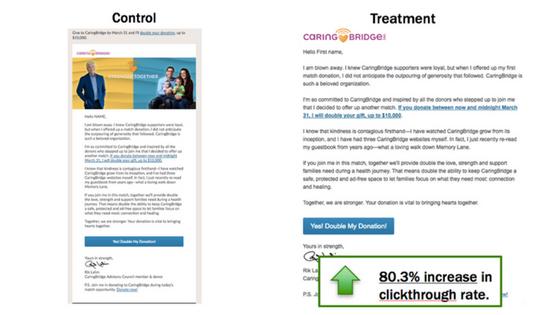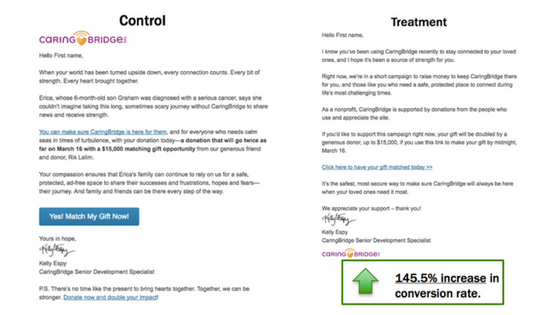Click here to read on Classy
by Brady Josephson
Brady Josephson is a charity nerd, entrepreneur, digital marketer, professor, and writer. He’s the vice president of innovation and optimization at NextAfter—a fundraising research lab and consultancy on a mission to unleash the most generous generation in the history of the world. Brady lives just outside Vancouver, British Columbia, and you can follow him on Twitter @bradyjosephson.
Here’s years of work, thousands of fundraising emails, and over 218 experiments on email fundraising summarized in one sentence:
People give to people, not marketing machines.
Now, you may be thinking, “is this another post telling me to be more human and personal in my fundraising communications” and the answer is “heck yes!” While it’s one thing to read about personalizing your fundraising communications, it’s another to put it into practice.
I know this firsthand because I’ve read through 1,242 emails (and counting) in the past two months for a study on online fundraising in Canada and I can tell you that the vast majority of fundraising emails—97 percent in fact—do not feel like I’m being communicated with but more like I’m being marketed to. And who wants to receive more marketing emails? I sure don’t. And neither do your donors.
If you’re just getting started, you might want to check out some email marketing basics first. But if you’re ready to next level your communications and learn how to really start resonating, dive in with me below.
How Do Real People Write Emails?
1. Real People Address Recipients by Name
Dear Friend.
How often do you receive an email from a friend that actually starts with that? Or an email that doesn’t have a greeting or salutation at all? I’m going to venture to guess not very often. And yet… that’s how many nonprofits address their donors, with nonspecific terms like friend or supporter, or worse, not at all.
Now it may not be intentional—you may have a lack of tools or data management best practices in place—but donors have no way of knowing this. All they understand is that the organization they support or follow doesn’t really know them. Which is unfortunate because, as Dale Carnegie puts it in his best-selling book How to Win Friends & Influence People, “… a person’s name is, to that person, the sweetest and most important sound in any language.”
It might seem simple, but small items like this can provide your organization with serious rewards. In fact, in an experiment we ran with The National Breast Cancer Foundation, we found that just by personalizing a fundraising email with a recipient’s first name they were able to increase the click-through rate by 270 percent.
In order to complete this effort, be sure to collect at least a person’s first name in your email acquisition process and then be sure to use this information to address your supporters appropriately.
2. Real People Start Relevant Conversations
How do you begin emails to your friends? Do you say hello? Mention the weather or something that’s happened recently? Or do you just dive right in like this:
In our XX year history, work with Y species has always been close to our hearts.
What in that sentence is relevant to the reader? The organization’s 30-year history? That they work with and care about Y species?
If the reader happens to also care about Y species then that’s at least remotely relevant–albeit not very conversational. How could we improve this opening, then?
If we flip the sentence around to something more like, “Do you care about species Y?” or “Did you know the population of species Y has been declining for 3 decades?” or “I noticed you’ve supported our work with species Y in the past so thought you’d like to know x.”
References to the recipient’s interest, actions, level of engagement or even to recent events, or holidays are conversational cues that allow people to engage with you on a human level.
If you wouldn’t open a conversation with it over coffee or a drink with someone you know, don’t open with it in an email to your donors.
Read Next: Guide to Nonprofit Welcome Emails
3. Real People Send Text Based Emails
Have you ever asked yourself why you send designed fundraising emails? Did someone—a donor, consultant, thought leader, etc.—tell you they wanted designed emails? Was it the default template for your email service provider? Did you just assume that if other organizations are doing it then it must be working so you should too? Have you tested it for yourself?
I ask these questions because these are the types of things I wrestled with when I was presented with experiment after experiment like this:

Or this follow-up experiment to that one:

The end result after testing and optimizing was an email ‘design’ that was… well… not really designed. A little logo at the bottom of the email and that was about it. The images and buttons were stripped away, and this produced a significant increase in clicks and donations.
Why? Because people don’t send HTML, highly designed emails with big ol’ buttons!
But when nonprofit organizations use emails that are overly designed—or even designed at all—readers immediately go into ‘I’m being marketed to mode’ and have more of a guard up. Yes, there are certainly organizations out there that have beautiful emails but that doesn’t mean that, when it comes to fundraising appeals, they might not get more clicks and donations if they too used less design.
The main takeaway here isn’t to just switch away from HTML emails to more text-based (although our experiments show you’ll more than likely get a donation lift if you do). The main takeaways are:
- Design can be a distraction to donors and has the potential to come across as too ‘market-y’
- Test this for yourself to see if this learning applies to your own audience
If your designers or communications team show hesitation, just ask them to run a test to validate any assumptions. At the end of the experiment, you’ll likely have solid information to move forward on. And I can bet you won’t find yourself saying, “Man, I really wish I didn’t run that test to learn what works and what my donors like.”
4. Real People Need Information Before They Make a Decision
How long should your email be? As digital marketing consultants at NextAfter, that’s a question we get asked a lot. And the answer: as long as it takes.
Asking people to make up their minds and commit to something before you give them enough information is a recipe for apathy. Or curious-but-ultimately-weak clicks (where they just bounce once they hit your landing page and see what you’re really trying to say and asking them to do).
Even if your nonprofit is an expert communicator throughout the year, it’s not likely that your community members wake up in the morning saying, “I sure want to give some money away today.” As such, in order to incite action in your fundraising emails, you need to state your case. You need to provide context. You need to convince them.
And that probably takes longer than you think. Here’s one of the more extreme examples from our research library:

Yes my friends, that 2,200-word email raised more than two times the already quite long email did.
Two key points here:
- The main goal of an email appeal is donations, not clicks
You might be able to get more clicks with shorter emails (or emails with video and more design elements) but a longer email may lead to more donations overall. It’s not really about the copy though, it’s about whatever does a better job at answering the donor’s questions and giving them a reason to not just click a link but to go on and donate. It’s not actually about length, it’s about communicating value!
- Test it for yourself
While our research and experiments from multiple clients and thousands of emails suggest that fundraising email appeals are more effective when they seek to communicate value through copy the only way to know for sure what resonates with your audience is to test it for yourself. Use the results I’ve presented as a launching pad to reassess your own strategy and perform A/B tests. Once you hit your sweet spot, you can make adjustments across the board. Build testing into your overall process to always keep a pulse on what resonates over time.
5. Real People Make Their Intentions Clear
When it comes to the purpose behind an email appeal and your specific call-to-action, it’s important to be direct and clear.
We have seen that it’s less effective when asking for donations to use call-to-action language like:
- Stand with us
- Learn more
- See how
These phrases might be a way to mix up your button copy, but ultimately, they’re not driving at the action you really want—a donation.
After you state your case and present your value proposition in a way the potential donor can understand, you can make your ask by reiterating the value a donor will get and hint at what’s to come when they click your call-to-action.
To meet a potential donors expectations when they click through to your campaign or donation page, use explicit language in your call-to-action, like:
- Donate now at [INSERT LINK]
- Your generous donation today will [INSERT IMPACT]
- Give your gift securely at [INSERT LINK]
- Make your year-end gift to [INSERT YOUR ORGANIZATION] today
While softer “bait and switch” language might get you more clicks, it often results in fewer donors (and more upset and unsubscribed followers).
Friends don’t trick friends into clicking links.
Ready To Get Real?
The way you start conversations with your donors, how much design you have (or don’t have), and the length of your copy will vary but the key point is, when it comes to email fundraising, people give to people, not marketing machines.
One last tip: read your next email draft out loud or print it off and have someone else read it out loud.
Does it sound like a human? Does it make you feel anything? Does it seem believable? If it passes for human, then give it a shot and test it against what you usually do. If it sounds like something a sentient ATM machine and your board members ‘collaborated’ on, rip it up, burn it to ashes, bury the ashes in your co-worker’s desk drawer as a fun prank, and try again.
For more tips on how to effectively communicate and steward your donors, access the extended sessions library from the Collaborative: Virtual Sessions, where you can watch all the recordings from the event and hear from industry leaders on fundraising and marketing best practices, data trends, leadership strategies, and more. The library will also include over 20 sessions that were not shown during the live event.
Watch Now—Collaborative: Virtual Sessions Recordings
Return to Insights & Events
